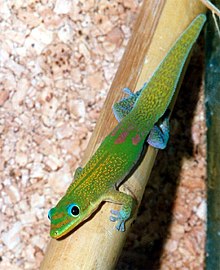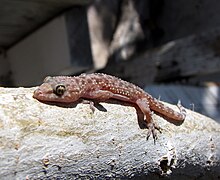 | |
| Gold dust day gecko (also known as Madagascar day geckos) | |
| Scientific classification | |
| Kingdom: | Animalia |
| Phylum: | Chordata |
| Class: | Reptilia |
| Order: | Squamata |
| Suborder: | Scleroglossa |
| Infraorder: | Gekkota |
| Family: | Gekkonidae Gray, 1825 |
| Subfamilies | |
| Aeluroscalabotinae Eublepharinae Gekkoninae Teratoscincinae Diplodactylinae | |
All geckos, excluding the Eublepharinae family, have no eyelids and instead have a transparent membrane which they lick to clean. Many species will, in defense, expel a foul-smelling material and feces onto their aggressors. There are also many species that will drop their tails in defense, a process called autotomy. Many species are well known for their specialized toe pads that enable them to climb smooth and vertical surfaces, and even cross indoor ceilings with ease (it is believed that the van der Waals force may contribute to this capability). These antics are well-known to people who live in warm regions of the world, where several species of geckos make their home inside human habitations. These species (for example the House Gecko) become part of the indoor menagerie and are often welcome guests, as they feed on insects, including mosquitoes.
The largest species, the Kawekaweau, is only known from a single, stuffed specimen found in the basement of a museum in Marseille, France and one documented sighting in the wild in 1870. This gecko was 60 cm (24 in) long and it was endemic to New Zealand where it lived in native forests. It was probably wiped out along with much of the native fauna of these islands in the late 19th century, when new invasive species such as rats and stoats were introduced to the country during European colonization. The smallest gecko, the Jaragua Sphaero, is a mere 16 mm long and was discovered in 2001 on a small island off the coast of the Dominican Republic.[2]
Contents |
Common traits
Geckos come in various colors and patterns such as purple, pink, blue,and also black geckos. Geckos are one of the most colorful lizards in the world.Some are subtly patterned and somewhat rubbery looking, while others are brightly colored. Some species can change color to blend in with their environment or with particular temperatures. Some species are parthenogenic, which means the female is capable of reproducing without copulating with a male. This improves the gecko's ability to spread to new islands. However, in a situation where a single female gecko populates an entire island, said island will suffer from a lack of genetic variation within the geckos that inhabit it. The Gecko's mating call sounds like a shortened bird chirping which attracts males when they are around so the female can create a baby with more genetic variation by using sexual reproduction instead of asexual. Geckos also make a quality pet for small households. They can live and breed in small tanks or terrariums. They must have proper living space to survive. The average temperature in the day should be between 78 and 88 degrees Fahrenheit (25 and 31 degrees Celsius) and at night temperatures should not go below 72 degrees Fahrenheit (22 degrees Celsius) inside the tank. Proper foods for the geckos range from small baby crickets, roaches, phoenix worms, and manufactured diets such as crested gecko diet. Many have a sweet tooth and like fresh fruits and honey.[3]
[edit] Gecko toes: setae and van der Waals forces
The toes of the gecko have a special adaptation that allows them to adhere to most surfaces without the use of liquids or surface tension. Recent studies of the spatula tipped setae on gecko footpads demonstrate that the attractive forces that hold geckos to surfaces are van der Waals interactions between the finely divided setae and the surfaces themselves. Every square millimeter of a gecko's footpad contains about 14,000 hair-like setae. Each seta has a diameter of 5 micrometers. Human hair varies from 18 to 180 micrometers, so a human hair could hold between 3 and 36 setae. Each seta is in turn tipped with between 100 and 1,000 spatulae.[4] Each spatula is 0.2 micrometer long[4] (one five-millionth of a meter), or just below the wavelength of visible light.[5]
Uroplatus fimbriatus clinging to glass.
Nocturnal vision
A study from the Lund University proved that nocturnal geckos such as the helmet gecko, Tarentola chazaliaei, discriminate colors in dim moonlight when humans are color blind. The sensitivity of the helmet gecko eye was calculated to be 350 times higher than human cone vision at the color vision threshold. The optics in the gecko's eyes, having distinct concentric zones of different refractive powers that constitute a multifocal optical system, together with the large cones of the gecko, are important reasons why they can use color vision at low light intensities. Although the intraspecific variation is large, in most of the individuals studied the concentric zones differed by 15 diopters. This is of the same magnitude as needed to focus light of the wavelength range to which gecko photoreceptors are most sensitive. In contrast, the optical system of a different day gecko species showed no signs of distinct concentric zones and is thereby monofocal. Another feature of the nocturnal geckos—and other lizards—in which they differ from most other vertebrates is that they only have cones in their retina.
The Family Gekkonidae is divided into five subfamilies, containing numerous genera of gecko species.

Gold dust day gecko licking nectar from the flower of a Strelitzia plant, also known as "bird of paradise."
- Subfamily Aeluroscalabotinae
- Genus Aeluroscalabotes, (monotypic) (A. felinus), Southeast Asia
- Subfamily Diplodactylinae, 17 genera, found in Oceania
- Genus Bavayia (11 species)
- Genus Carphodactylus (monotypic)
- Genus Crenadactylus (monotypic)
- Genus Diplodactylus (40 species)
- Genus Eurydactylodes (4 species)
- Genus Hoplodactylus (10 species)
- Genus Lucasium (monotypic)
- Genus Naultinus (8 species)
- Genus Nephrurus (11 species)
- Genus Oedura (16 species)
- Genus Phyllurus
- Genus Pseudothecadactylus
- Genus Rhacodactylus
- Genus Rhynchoedura
- Genus Saltuarius
- Genus Strophurus
- Genus Underwoodisaurus
- Subfamily Eublepharinae, 5 genera
- Genus Coleonyx
- Genus Eublepharis
- Genus Goniurosaurus
- Genus Hemitheconyx
- Genus Holodactylus
- Subfamily Gekkoninae, 74 genera worldwide, some of the biggest genera are:
- Genus Gehyra, Web-toed Geckos or Dtellas
- Genus Gekko, true geckos
- Genus Hemidactylus
- Genus Phelsuma, day geckos, most are endemic to Madagascar.
- Genus Phyllodactylus, leaf-toed geckos
- ...
- Subfamily Teratoscincinae, wonder geckos
- Genus Teratoscincus (7 species)
- Pachydactylus, genus of geckos of which there are many species.
- Bibron's gecko, Pachydactylus bibroni — Native to Southern Africa, this hardy arboreal gecko is considered a household pest.
- Crocodile gecko or Moorish gecko, Tarentola mauritanica — very strong and heavily built for their size usually growing up to 15 cm (6 in). They are commonly found in the Mediterranean region from the Iberian Peninsula and southern France to Greece and northern Africa. Their most distinguishing characteristic is their pointed head and spiked skin with their tail resembling that of a crocodile's.
- Cyrtopodion, genus of geckos of which there are many species.
- Cyrtopodion brachykolon; commonly known as "bent-toed gecko", found in north-western Pakistan.
- Rhacodactylus, genus of Geckos of which there are a few species.
- Suras Gecko belonging to the genus Rhacodactylus.
- Crested gecko, Rhacodactylus ciliatus — Believed extinct until rediscovered in 1994. Gaining in popularity as a pet.
- Gargoyle gecko, Rhacodactylus auriculatus — commonly known as the New Caledonian bumpy gecko or gargoyle gecko.
- Gold dust day gecko (Phelsuma laticauda laticauda (Boettger, 1880) (syn. Pachydactylus laticauda Boettger, 1880)) is a diurnal subspecies of geckos. It lives in northern Madagascar and on the Comoros.
- Golden Gecko, Gekko ulikovskii — native to the warm rainforests of Vietnam.
- Hemidactylus, genus of geckos of which many varieties belong.
- Common House Gecko, Hemidactylus frenatus — A species that thrives around man and human habitation structures in the tropics and subtropics world wide.
- Indo-Pacific Gecko, Hemidactylus garnotii — Also known as a fox gecko because of its long, narrow snout. This species is found in houses throughout the tropics. This gecko may eat leafcutter ants.
- New Caledonian giant gecko, Rhacodactylus leachianus — first described by Cuvier in 1829, is the largest of the Rhacodactylus geckos.
- Leopard gecko, Eublepharis macularius — The most common gecko kept as a pet is the leopard gecko, which does not have toe pads with setae, but rather claws. These enable it to more easily climb on rough surfaces like tree bark. This gecko cannot climb the glass of a terrarium. The leopard gecko tends to be docile and calm. This gecko can eat butterworms, cockroaches, crickets, mealworms, waxworms, superworms, and pink mice.
- Mediterranean gecko, Hemidactylus turcicus — residential and wild, introduced species (USA).
- Mourning gecko, originally an East Asian and Pacific species, Lepidodactylus lugubris is equally at home in the wild as in residential neighborhoods. Found in Hawaii, it may have been an early Polynesian introduction. A parthenogenic species. There is a report from Hawaii of someone having seen a larger gecko of this type eating a smaller one (or rather, running away from view with a smaller gecko halfway out of its mouth) on three or more occasions.[citation needed]
- Ptychozoon, — a genus of arboreal gecko from Southeast Asia, known as Flying Geckos or Parachute Geckos, has wing-like flaps from the neck to the upper leg, to help it conceal itself on trees and provide lift while jumping.
- Stump-toed gecko, Gehyra mutilata (Peropus mutilatus) — This gecko, commonly referred to as a gheckl, can vary its color from very light to very dark to blend into a background. At home in the wild as well as in residential neighborhoods.
- Tree gecko, Hemiphyllodactylus typus — Tree geckos are forest dwellers.
- Tokay gecko, Gekko gecko — a large, common, Southeast Asian gecko known for its aggressive temperament, loud mating calls, and bright markings.
- Western banded gecko, Coleonyx variegatus — Native to southwestern United States and northwest Mexico.
- Dwarf gecko, Sphaerodactylus ariasae — native to the Caribbean islands, and the world's smallest lizard




No comments:
Post a Comment